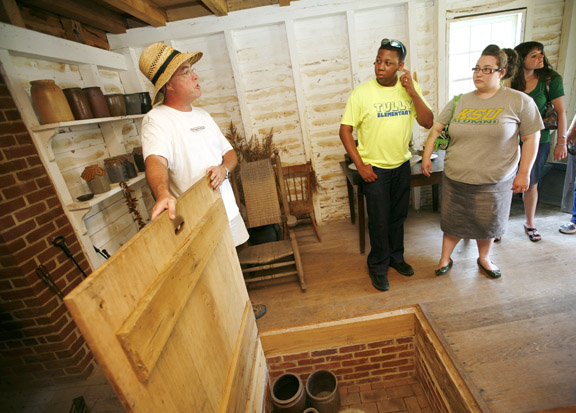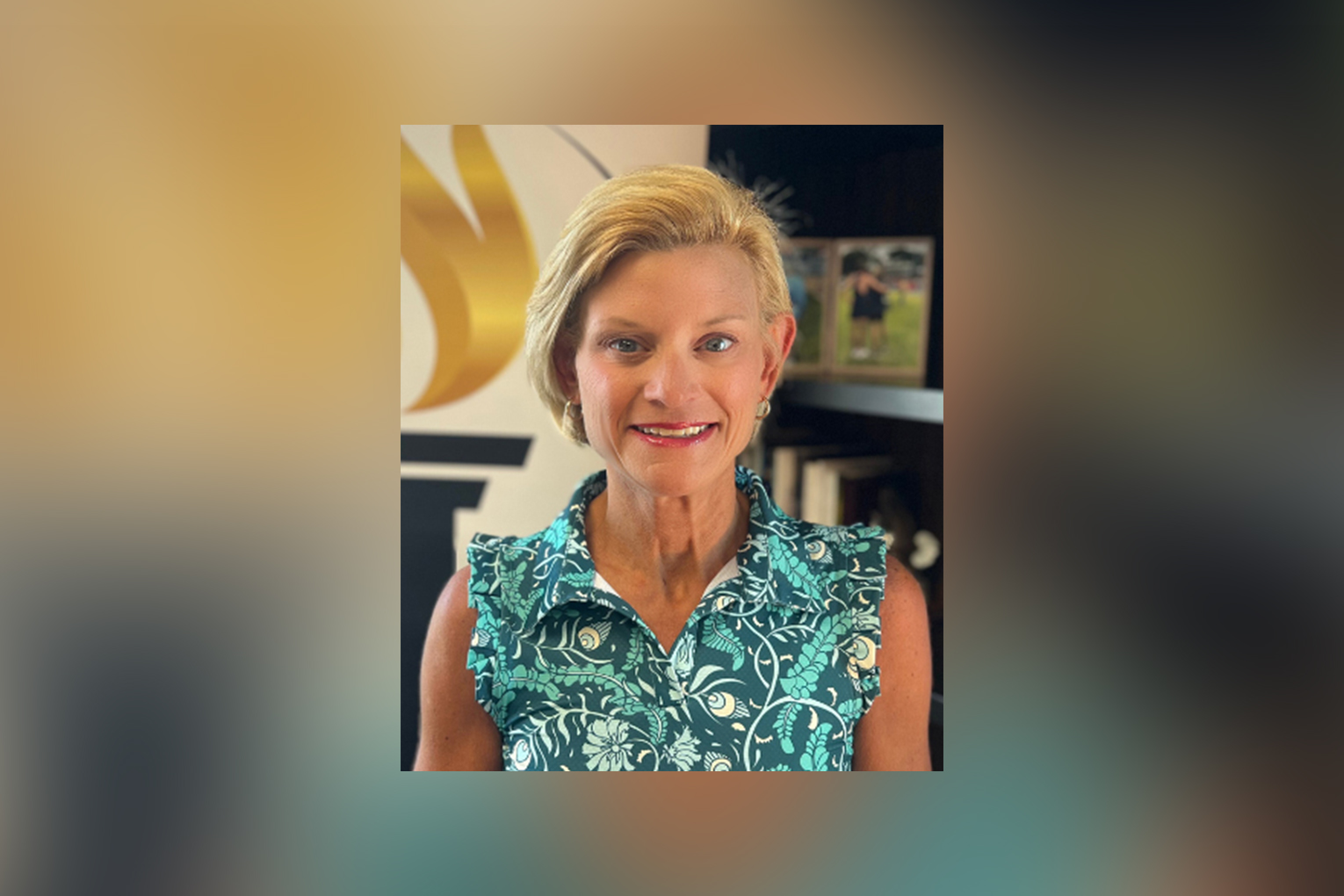
Terry and Sarah Hodges listen to tour guide Frank Webster, left, talk about the standalone kitchen at Riverside, the Farnsley-Moremen Landing, during the Project Archaeology workshop in Louisville June 22, 2010. Terry Hodges is a kindergarten assistant at Tully Elementary School (Jefferson County), and Sarah Hodges is a 3rd-grade teacher at Greenwood Elementary School (Jefferson County). Photo by Amy Wallot
Teachers use archaeology to bring other subjects to life
By Matthew Tungate
Students in schools across Kentucky are using buttons to learn about sorting, color, shapes and classification, all while drawing inferences about the objects’ owner. Teachers are using original source documents to produce informed citizens, voters and leaders.
All are happening because of archaeology, a word not even found in the Program of Studies, according to A. Gwynn Henderson, archaeologist and education coordinator with the Kentucky Archaeological Survey (KAS), jointly administered by the Kentucky Heritage Council and the University of Kentucky Department of Anthropology.
“Archaeology is not just digging up bones – it’s not dinosaurs,” Henderson said. “It’s a way to learn about past peoples by studying the objects they left behind and the patterns of those objects.”
KAS has offered a national professional-development program called Project Archaeology since the mid-1990s, Henderson said. It consists of three components: workshops, high-quality educational materials and continuing professional development.
Project Archaeology workshops are held in the summer and led by a KAS archeologist and a classroom teacher. Participants engage in discussions and activities about archaeology and how to use it in their classrooms.
“Once we start the workshop, there’s absolutely no question, based on educators’ responses and the evaluations we’ve gotten, that they see the importance of it,” Henderson said.
Teachers also receive lots of curriculum and Kentucky-focused materials, including Intrigue of the Past, a book that includes 24 lessons that address multiple learning and teaching styles, and includes many hands-on activities. Project Archaeology lessons are aligned with Kentucky’s Core Content and Program of Studies and will be aligned with new standards, she added.
“We want to send them home loaded down with content, lessons, lists of resources, links to websites and opportunities for inserting that information directly into their classroom,” Henderson said.
A vehicle for teaching
Jill Reverman, who teaches mathematics, social studies and writing at Nichols Elementary School (Bullitt County), attended a Project Archaeology workshop in 2009 and thinks it is a good opportunity for teachers to get students interested in the past.
“I think any time you can use something real or real-world, the students are much more interested and they see relevance to real life,” she said.
Reverman said she used the information she learned at the workshop when discussing the use of primary sources to study history in social studies class. She showed students that archaeologists and historians use artifacts to piece together the story of the past.
She also used some of the lessons such as “The Archaeology of Me,” where students brought in items from their homes, and the class tried to piece together what they could learn about that person from their “artifacts.”
“I chose that lesson because it showed how real archeologists work, piecing together clues that they find about a person’s life,” Reverman said. “I think students learned how archaeologists work and helped to explain how historians know so much about the past.”
Theresa Falder teaches American government, AP American Government and Politics, and archaeology at Livingston County High School. She also has served as a Project Archaeology facilitator and finds many ways to incorporate archaeology into her classes.
She said she uses about 95 percent of the lessons in Intrigue of the Past in her archaeology class. “It works so well because the Project Archaeology curriculum takes such a ‘hands-on’ approach to learning,” Falder said.
In government classes, she said she has incorporated lessons concerning culture, the importance of history and observation and inference.
“When we cover the early formation of governments, we have a discussion about the archaeology of prehistoric man. We discuss how archaeological research has increased our knowledge of the social structure of prehistoric man, which includes the formation and evolution of government,” Falder said. “Finally, we discuss the archaeology that has been conducted at places like George Washington’s home, Mount Vernon, and Andrew Jackson’s home, The Hermitage. I feel that this allows my students to gain a better understanding of the Founding Fathers and our country’s early leaders, especially when it comes to issues like liberty and equality.”
She said she became a workshop facilitator, which required additional training, because she sees the value of the curriculum for teachers.
“It presents so many topics, not just archaeology, in a fun and engaging way,” Falder said. “In addition to archaeology, it also incorporates social studies, science, sociology, mathematics, logic, psychology and art. ”
Shannon Miller, who teaches 5th-grade reading and writing at Greenwood Elementary School (Jefferson County), has a bachelor’s degree in anthropology and attended her first Project Archaeology workshop last summer.
She said she learned some interesting ways to take a concept in reading, like inference, and connect it to archaeology. Miller also likes that there are many opportunities to teach respect for other cultures and history through archaeological experiences.
“I think I will use archaeological texts and exercises in literacy and writing centers,” she said. “I can easily tie in reading and writing concepts to the study of archaeological concepts.”
Henderson said KAS is trying to inform teachers that they can use archaeology in many subjects, as workshop attendance has been dwindling in recent years.
The teachers who have attended said their counterparts are missing out.
Miller said teachers who don’t go are missing the opportunity to connect concepts and strategies they are already teaching into a new exciting field.
“Students love the mystery and problem-solving aspects of a field such as archaeology,” she said. “With a little creativity, we can create a bridge with other subjects (math, science, reading and writing). It is also the perfect avenue for higher-level thinking and the scientific method of thinking and doing. It makes them critical thinkers about history and encourages that depth of thought on every subject.”
Falder agreed.
“If they give it a chance and actually try some of the lessons in their classroom, I think they will find what a great resource it really is,” Falder said. “I haven’t found a student yet who didn’t like archaeology.”
MORE INFO …
A. Gwynn Henderson, gwynnhenderson@uky.edu, (859) 257-1919




Leave A Comment